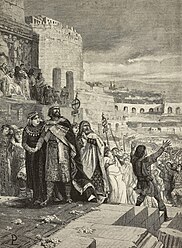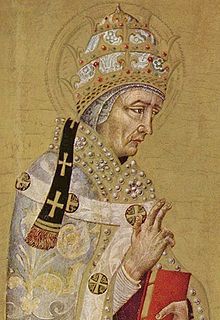Related Research Articles
Pope Benedict VIII was the bishop of Rome and ruler of the Papal States from 18 May 1012 until his death. He was born Theophylact to the noble family of the counts of Tusculum. Unusually for a medieval pope, he had strong authority both in Rome and abroad.
Pope Benedict IX, born Theophylactus of Tusculum in Rome, was bishop of Rome and ruler of the Papal States on three occasions between October 1032 and July 1048. Aged approximately 20 at his first election, he is one of the youngest popes in history. He is the only man to have been pope on more than one occasion and the only man ever to have sold the papacy.
Pope Sylvester III, born John in Rome, was bishop of Rome and ruler of the Papal States from 20 January to March 1045.
Benedict X was born Giovanni, a son of Guido, a brother of the notorious Pope Benedict IX, a member of the dominant political dynasty in the region at that time. He reportedly later was given the nickname of Mincius (thin) due to his ignorance.

Marozia, born Maria and also known as Mariuccia or Mariozza, was a Roman noblewoman who was the alleged mistress of Pope Sergius III and was given the unprecedented titles senatrix ("senatoress") and patricia of Rome by Pope John X.
Pope John XIII was the bishop of Rome and ruler of the Papal States from 1 October 965 to his death. His pontificate was caught up in the continuing conflict between the Holy Roman emperor, Otto I, and the Roman nobility. After long and arduous negotiations, he succeeded in arranging a Byzantine marriage for Otto II, in an effort to legitimize the Ottonian claim to imperial dignity. He also established church hierarchy in Poland and Bohemia.
Pope John XIX, born Romanus, was bishop of Rome and ruler of the Papal States from 1024 to his death. He belonged to the family of the powerful counts of Tusculum, succeeding his brother, Benedict VIII. Papal relations with the Patriarchate of Constantinople soured during John XIX's pontificate. He was a supporter of Emperor Conrad II and patron of the musician Guido of Arezzo.

Saeculum obscurum, also known as the Pornocracy, was a period in the history of the Papacy during the first two-thirds of the 10th century, beginning with the installation of Pope Sergius III in 904 and lasting for sixty years until the death of Pope John XII in 964. During this period, the popes were influenced strongly by a powerful and allegedly corrupt aristocratic family, the Theophylacti, and their relatives and allies. The era is seen as one of the lowest points of the history of the Papal office.
Theophylact I was a medieval count of Tusculum who was the effective ruler of Rome from around 905 through to his death in 924. His descendants controlled the papacy for the next 100 years.
Alberic II (912–954) was ruler of Rome from 932 to 954, after deposing his mother Marozia and his stepfather, King Hugh of Italy.

The counts of Tusculum were the most powerful secular noblemen in Latium, near Rome, in present-day Italy between the 10th and 12th centuries. Several popes and an antipope during the 11th century came from their ranks. They created and perfected the political formula of noble-papacy, wherein the pope was arranged to be elected only from the ranks of the Roman nobles. The pornocracy, the period of influence by powerful female courtesans of the family, also influenced papal history.
Alberic I was the Lombard Duke of Spoleto from between 896 and 900 until 920, 922, or thereabouts. He was also Margrave of Camerino, and the son-in-law of Theophylact I, Count of Tusculum, the most powerful man in Rome.

Crescentius the Elder was a politician and aristocrat in Rome who played a part in the papal appointment.
Ptolemy I was the count of Tusculum in the first quarter of the twelfth century. He was a son of Gregory III. Peter Pisanus, in his Vita Paschalis II refers to Ptolemy and the abbot of Farfa as the allies of the emperor in the same way that the Saints Peter and Paul were the allies of the pope.
Gregory I was the Count of Tusculum sometime between 954 and 1012. Consul et dux 961, vir illustrissimus 980, praefectus navalis 999. He was the son of Alberic II, and Alda of Vienne. His half-brother was Pope John XII.
Gregory II was the son of Alberic III, Count of Tusculum and Ermelina. He was the Count of Tusculum and the Lateran from 1044 to his death.
Peter was a medieval Roman noble. Like his father, he carried the illustrious title of Romanorum patricius, consul, dux et senator, implying his secular command over Rome and its militia. He was the son of Alberic III, Count of Tusculum. As a result, he was a descendant of Theophylact I, Count of Tusculum.

Papal appointment was a medieval method of selecting a pope. Popes have always been selected by a council of Church fathers, however, Papal selection before 1059 was often characterized by confirmation or nomination by secular European rulers or by their predecessors. The later procedures of the papal conclave are in large part designed to constrain the interference of secular rulers which characterized the first millennium of the Roman Catholic Church, and persisted in practices such as the creation of crown-cardinals and the jus exclusivae. Appointment might have taken several forms, with a variety of roles for the laity and civic leaders, Byzantine and Germanic emperors, and noble Roman families. The role of the election vis-a-vis the general population and the clergy was prone to vary considerably, with a nomination carrying weight that ranged from near total to a mere suggestion or ratification of a prior election.

There was no uniform procedure for papal selection before 1059. The bishops of Rome and supreme pontiffs (popes) of the Catholic Church were often appointed by their predecessors or by political rulers. While some kind of election often characterized the procedure, an election that included meaningful participation of the laity was rare, especially as the popes' claims to temporal power solidified into the Papal States. The practice of papal appointment during this period would later result in the jus exclusivae, i.e., a right to veto the selection that Catholic monarchs exercised into the twentieth century.

The Tusculan Papacy was a period of papal history from 1012 to 1048 where three successive relatives of the counts of Tusculum were installed as pope.
References
- ↑ John-Peter Pham, Heirs of the Fisherman : Behind the Scenes of Papal Death and Succession, (Oxford University Press, 2004), 56.